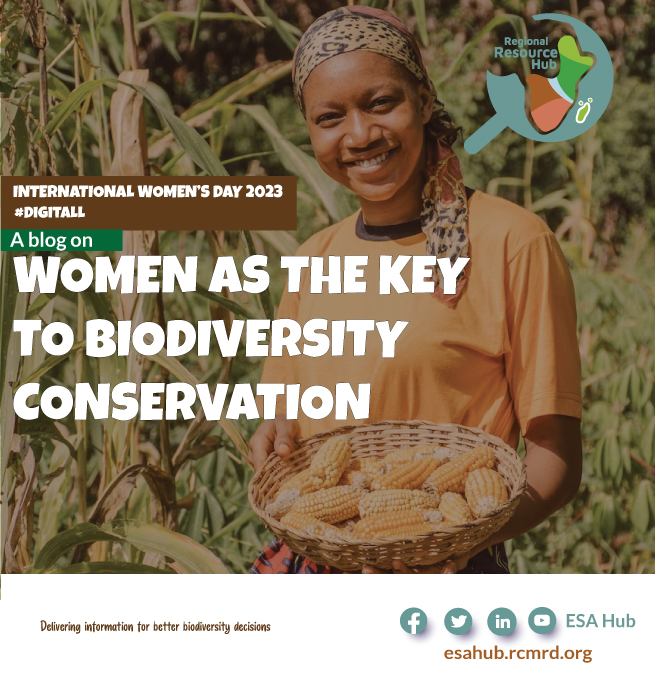Experts estimate that we are losing more than 10,000 species to extinction per year, a rate that is 1,000 times faster than at any other time in human history. These trends have serious implications for the well-being of those who depend on the environment for basic needs and for all of humanity at large. Consider, for example, the COVID-19 pandemic, whose origin and the ensuing socio-economic crisis are ultimately ecological. Encroaching on and destroying wild spaces and the species that inhabit them is essentially destroying our first line of defense provided by healthy ecosystems.
Women in many parts of the world, especially women in rural communities, are among the first to experience the devastating impact of this extinction. The loss of biodiversity also poses a disproportionate burden for women and girls by increasing the time required to obtain necessary resources such as water, fuel wood, and medicinal plants, which reduces the time they can spend on income generating activities and education. This in turn diminishes their capacity to have a say in the conservation and management of their communities’ natural resources.
Women are underrepresented in the biodiversity conservation world and according to the World Economic Forum’s latest Global Gender Gap Index, gender equality is still almost a century away at the current pace of change. Although, beyond equity, enabling women’s full engagement in biodiversity decisions is critical to ensure that biodiversity conservation and sustainable use efforts are successful in the long term. Without the contributions and buy-in of women and girls, these efforts risk overlooking the root causes of biodiversity loss, as well as potential solutions, and may continue to perpetuate gender inequalities.
While the fact that women comprise half the world’s population should be enough to secure equal inclusion in conservation efforts, they are often particularly well-positioned to rally local support for animals whose survival hinges on the people who share their habitats. Further, research shows that including women in forest and fishery management groups can result in better resource governance and conservation outcomes. In fact, in Rwanda, land tenure reforms that reduce gender barriers to land ownership have led to a significant increase in soil conservation investment by female-headed households.
Therefore, it is crucial to increase the representation of women in decision-making roles related to biodiversity and environmental governance at all levels. To achieve this, it is necessary to mitigate both cultural and logistical barriers to allow women to express their needs, knowledge, priorities, and solutions in relation to sustainable development. Equal rights and access to ownership and control over land are also critically important for women across the world.
There is also a need to spread awareness among women and girls of proposed biodiversity-related actions that affect them and build their knowledge about their rights and their options for contributing to shaping those actions. It is also critical to elicit the full engagement and support of men and boys in order to empower women and girls to participate in biodiversity conservation. Men and boys understanding and support of measures for women’s empowerment will foster acceptance of these measures by the community. An inclusive approach would also contribute to addressing the root causes of inequalities through creating awareness and promoting long-term beneficial action.
The United Nations Convention on Biodiversity (CBD) is designed to protect the planet’s biological diversity. It is based on the recognition that biological diversity is a global asset under threat and commits governments to conservation, the sustainable use of biological diversity, and the sharing of benefits. During the fifteenth meeting of the Conference of Parties to the CBD, Member States agreed on the historic Kunming-Montreal Global Biodiversity Framework that has four goals and 23 targets to be achieved by 2030.
Targets 22 and 23 implore Member States to ensure full, equitable, inclusive, effective, and gender-responsive representation and participation in decision-making.
Target 23 specifically calls for gender equality in the implementation of the framework through a gender-responsive approach where all women and girls have equal opportunity and capacity to contribute to the three objectives of the Convention, including by recognizing their equal rights and access to land and natural resources and their full, equitable, meaningful, and informed participation and leadership at all levels of action, engagement, policy, and decision-making related to biodiversity.
Access to information empowers women to make more effective decisions, for example, in relation to land use. It enables women to understand and exercise their full range of rights and participate more meaningfully in public life. Access to information bridges gender gaps and helps shift power in decision-making processes. It can also link women with the needed resources for achieving economic empowerment. With genuine access to information, women can more easily take advantage of opportunities and make more effective decisions about land use and ownership and agricultural practices and opportunities. There are several platforms women can use to build and strengthen their capacity to participate more effectively in biodiversity conservation. One such platform is the Regional Resource Hub (RRH). The RRH is a knowledge hub for the Eastern and Southern African Region that supports better decision making for fair and effective management and governance of protected and conserved areas. The Hub compiles and analyses relevant data and provides information to support policy dialogue and the decision-making process at the local, national, and regional level.
Women’s enormous potential to contribute to biodiversity conservation and sustainable development is yet to be fully explored. As we implement the CBD over the next decade, we must prioritize enhancing the participation and engagement of women and girls. This means striving to expand their ranks on all fronts, particularly in regions and cultures where they may still face inequality. It will take continued effort and support to make gender parity in biodiversity conservation a reality. However, governments and international and national partners are increasingly recognizing and advocating for more attention to gender issues. This thus gives hope for a fair and thriving future.




